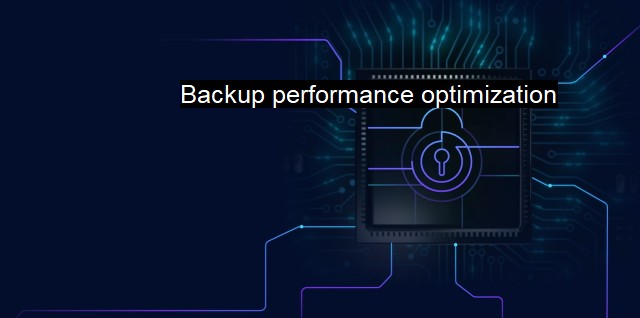What is Backup performance optimization?
Maximizing Data Recovery Speed and Efficiency: The Importance of Backup Performance Optimization in Cybersecurity and Antivirus
Backup performance optimization is a critical component within the purview of cybersecurity and antivirus systems. It involves employing strategies, technologies, and methodologies that improve the functionality of data backups. From restoring stored data to overcoming a system’s vulnerability, the optimization mechanism ensures a swift recovery process when data corruption, computer viruses, hacking threats, or physical damage strikes.Backup performance optimization plays a pivotal role in ensuring data safety, availability, and minimal potential loss. Effective backup performance optimization would be impossible without proper evaluation and understanding of an organization's digital assets and managing the frequency of data backups. Many organizations are setting up their backup strategies depending on the significance the data has in order to keep critical data secured and retrievable at all times.
In the context of antivirus activities, backup performance optimization functions are vital for limiting potential data loss due to malware attacks. Certain kinds of malware, such as ransomware, specifically target the computer's stored data. Antivirus software makes use of backup performance optimization to deliver an immediate recovery option when such threats manifest themselves. Backup solutions optimized for performance therefore remain crucial to re-establishing normal operations after a malware attack.
Unique from other fields, the discipline of cybersecurity revolves around the objective to protect cyberspace from threats, both foreseeable and unforeseeable. The potential loss from security breaches is immense and in some instances, irreversible. Efficiently optimized backing systems facilitate businesses to swiftly recover their data.
Backup performance optimization involves various techniques and methods. Some of these include deduplication, compression, and block-level backup. Deduplication can significantly eliminate redundant copies of previously backed up data, which results in less storage space used. Compression is another technique involving reducing the size of data before backing it up. Block-level backup only backs up changed parts of a file rather than backing up the entire file again, saving both time and storage space.
Although backup performance optimization largely depends on automated processes, the human factor cannot be understated. IT teams should continuously research new backup optimization methods, evaluate software potential, and oversee all backup operations to get the maximum optimization.
In another context, backup performance optimization is also crucial to counter physical risks to data integrity, including hardware failures and natural disasters. Enterprises usually have in-place strategies for disaster recovery, which are intrinsically dependent on fast and reliable data backup systems. Performance-optimized backup systems save time and reduce downtime, which is critical when faced with an unplanned disruption.
Every layer of protection applied within an organization's digital infrastructure - antivirus, firewall, redundant data storage, multifactor authentication, and intrusion detection systems - add to the saga of securing the digital realm. none of these defenses can serve their intended purpose if not for efficient backup performance optimization.
Ensuring an effective backup performance optimization should be a priority for every organization. By establishing solid backup protocols, companies can safeguard their data from potential threats like cyberattacks, physical damage, or hardware failure, ensuring a smoother and quicker recovery process. Thus, in the realm of cybersecurity and antivirus systems, backup performance optimization stands as a cornerstone of a resilient and robust architecture.
Any organization serious about data protection should ensure their backup systems are fully optimized for performance. Backup performance optimization is not simply about saving storage space, but about quickly recovering data for business continuity. As cyber threats become more sophisticated, regular assessments of backup performance optimization practices and continuous enhancements will make a significant difference in safeguarding businesses from extensive data loss and costly downtime.

Backup performance optimization FAQs
What is backup performance optimization?
Backup performance optimization is the process of configuring and tuning backup systems to maximize their efficiency and speed. This includes optimizing hardware and software configurations, selecting appropriate backup strategies, and implementing best practices for backup management.Why is backup performance optimization important in cybersecurity and antivirus?
Backup performance optimization is important because effective backup systems are essential for data protection and disaster recovery. In the event of a cybersecurity attack or virus outbreak, a well-optimized backup system can help minimize data loss and downtime by quickly restoring critical systems and data.What are some common techniques for backup performance optimization in cybersecurity and antivirus?
Common techniques for backup performance optimization in cybersecurity and antivirus include using incremental backups, compressing backup data, deduplicating backup data, and leveraging cloud-based backup solutions. Other techniques may include tuning backup hardware and software configurations, implementing backup testing and validation procedures, and optimizing the backup schedule.How can I determine if my backup system is properly optimized for cybersecurity and antivirus?
To determine if your backup system is properly optimized for cybersecurity and antivirus, you can conduct a backup performance assessment. This assessment will evaluate the current state of your backup system, identify any areas that need improvement, and provide recommendations for optimizing backup performance. You can also monitor backup metrics like backup completion time, backup storage usage, and backup success rate to identify potential performance issues.| | A | | | B | | | C | | | D | | | E | | | F | | | G | | | H | | | I | | | J | | | K | | | L | | | M | |
| | N | | | O | | | P | | | Q | | | R | | | S | | | T | | | U | | | V | | | W | | | X | | | Y | | | Z | |
| | 1 | | | 2 | | | 3 | | | 4 | | | 7 | | | 8 | | |||||||